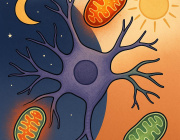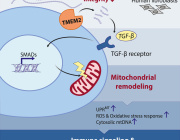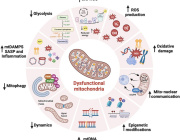Mitochondria targeting anti-tumor compound
The compound folic acid-conjugated methyl-BETA-cyclodextrin (FA-M-BETA-CyD) has significant antitumor effects on folate receptor-ALPHA-expressing (FR-ALPHA (+)) cancer cells, researchers have found. The compound significantly reduced ATP production while simultaneously increased the production of reactive oxygen species. Side effects in animal models were minimal but further testing is still required to determine its safety.
Scheme for the mechanism of mitophagy induction by FA-M-?-CyD as proposed by researchers from Kumamoto University, Japan.Credit: Adapted from Kameyama, K.; Motoyama, K.; Tanaka, N.; Yamashita, Y.; Higashi, T. & Arima, H., Induction of mitophagy-mediated antitumor activity with folate-appended methyl-BETA-cyclodextrin, International Journal of Nanomedicine, Dove Medical Press Ltd., 2017, Volume 12, 3433-3446. DOI: 10.2147/ijn.s133482 under the CC-BY-NC license. Credit Professor Hidetoshi Arima
Autophagy is a natural cellular mechanism that plays an important role in cellular homeostasis by removing or recycling damage cell components. Mitophagy is autophagy that is specific to mitochondria. The mitochondrion is an organelle responsible for several functions including the production of cellular energy and the initiation of cell death. The removal of damaged mitochondria prevents degeneration of healthy cells, and recent research has found that it is a potentially potent treatment for cancer since mitophagy activation in cancer tissue induces cancer cell death.
In a previous study from Kumamoto University in Japan, researchers developed folic acid-conjugated methyl-α-cyclodextrin (FA-M-β-CyD) which targets folate receptor-α (FR-α)-expressing (+) tumor cells via an unknown autophagic mechanism. The researchers theorized that FA-M-β-CyD inhibited mitochondrial activities, and began experimenting with the compound on a HeLa-derived, cervical cancer cell line (KB cells).
The researchers first evaluated FA-M-β-CyD by comparing its effects with that of three other compounds, as well as a control, on spheroids of FR-α (+) KB cells in vitro. They found that FA-M-β-CyD reduced cancer cell viability significantly more than the other compounds due to its FR-α-mediated cytotoxicity.
Next, the researchers determined that FA-M-β-CyD was localized to the FR-α? (+) KB cell mitochondria and that it significantly increased the mitochondrial transmembrane potential compared to the other compounds tested. The transmembrane potential of the mitochondria controls the energy (ATP) production of the cell, and it was further found that ATP production was significantly reduced in FR-α (+) KB cells. However, when FR-α (-) A549 cancer cells were treated with FA-M-β-CyD, ATP production was not affected.
Kumamoto University researchers then focused on the effect that FA-M-β-CyD had on KB cell ROS production since reactive oxygen species (ROS) are frequently generated by the mitochondria. They found that ROS production was significantly increased in FR-α (+) KB cells but was unaffected in FR-α (-) KB cells. Furthermore, through the production of ROS in FR-α (+) KB cells, FA-M-β-CyD also seemed to cause autophagic vacuole creation.
In vivo experiments of FA-M-β-CyD's antitumor effects in KB cells (FR-α (+)) using human xenograft models showed promise. Not only did a single dose of the compound significantly suppress tumor growth, but there also didn't appear to be any significant major side effects as demonstrated by body weight and blood tests. However, further tests at higher doses are required to confirm the safety of the compound, but the researchers are cautiously optimistic.
"One of the problems for antitumor drugs to overcome is the abnormal blood vessel distribution and blood perfusion in tumors. This hinders the ability of the drug to enter cells and do its job," said Professor Arima, one of the project leaders. "However, recent research has found that nanoparticles around 12 nanometers in size can easily enter tumor cells. FA-M-β-CyD was measured at approximately 10 nm which contributes to its anticancer abilities." The compound should target FR-α? (+) cancer cells, such as those found in ovarian, kidney, breast, endometrium, bladder, lung, and pancreas cancers, but the researchers admit that further testing is required before the safety of the compound can be determined definitively. It is hoped, however, that it will be developed into a potent anticancer drug.
This research can be found online at Dove Medical's International Journal of Nanomedicine.
News source: Kumamoto University. "Mitochondria targeting anti-tumor compound." ScienceDaily. ScienceDaily, 26 June 2017.































































